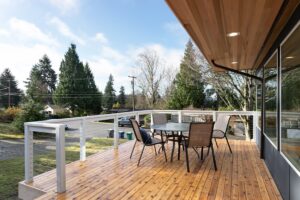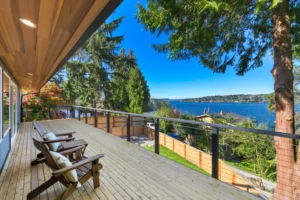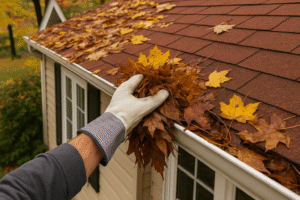If you’re searching for roof cleaning in Bellevue, chances are you’ve started to notice moss creeping across your shingles, dark streaks forming near the gutters, or piles of damp debris collecting after weeks of rain. These are all classic signs of roof neglect — and they’re especially common in Bellevue’s lush, moisture-heavy climate.
Between our year-round drizzle, tall evergreen trees, and shaded neighborhoods, roofs in the Pacific Northwest face constant exposure to moisture and organic buildup. Over time, this combination can trap water beneath shingles, weaken your roof’s structure, and even shorten its lifespan. That’s why routine roof cleaning isn’t just about improving curb appeal — it’s an essential part of maintaining your home’s value and performance.
In this guide, we’ll walk you through everything Bellevue homeowners should know before hiring a professional roof cleaning service — including how the process works, what it costs, and how to choose a reliable local expert. Whether you live near Lake Hills, Clyde Hill, or downtown, keeping your roof clean and moss-free can help prevent costly repairs down the road.
To learn more about our process and materials, explore our professional roof cleaning services in Washington. And if you’re looking for a trusted Bellevue roofing contractor, Orca Roofing & Exteriors offers local expertise built around the unique needs of Eastside homes.
Why Roof Cleaning Matters in Bellevue’s Climate
Bellevue’s natural beauty comes with a challenge for homeowners — constant moisture. With steady rainfall, dense tree cover, and limited sunlight in many neighborhoods, local roofs rarely get the chance to dry completely. The result? Persistent moss, algae, and lichen growth that slowly eats away at your roof’s protective layers.
In areas like Clyde Hill, Bridle Trails, and Somerset, homes are often surrounded by evergreens whose fallen needles trap moisture on shingles. Even modern composite or metal roofs aren’t immune — organic buildup can block drainage paths, leading to trapped water and premature deterioration.
When left untreated, moss roots lift and separate shingles, allowing rain to seep into the underlayment. This can cause wood rot, leaks, and even structural damage over time. Beyond that, dark algae streaks absorb more heat, which can shorten the roof’s lifespan by years.
That’s why roof cleaning in Bellevue isn’t just cosmetic — it’s preventive maintenance. A professional cleaning removes the moss and grime that accelerate wear and tear, helping your roof perform better and last longer in our wet Northwest climate. Regular maintenance protects your investment, improves curb appeal, and ensures your home stays watertight through every season.
How Professional Roof Cleaning Works
Professional roof cleaning in Bellevue is more than just rinsing off the surface — it’s a detailed, multi-step process designed to safely restore your roof while protecting its materials. Here’s what typically happens when you schedule a professional cleaning service:
1. Roof inspection and safety setup
Before any cleaning begins, technicians perform a full roof inspection to identify areas with heavy moss, damaged shingles, or potential leak points. Safety lines and protective gear are then set up to ensure secure access to every section of your roof.
2. Debris removal by hand or blower
The first cleaning step involves removing loose debris — like pine needles, branches, and leaves — using hand tools or a low-pressure blower. This clears the surface so the moss and algae can be treated directly without obstruction.
3. Soft washing and eco-safe moss treatment
Unlike harsh pressure washing, which can damage shingles and strip protective granules, reputable companies such as Orca Roofing & Exteriors use a soft wash method. This technique applies low-pressure water combined with biodegradable cleaning solutions to gently kill moss, algae, and lichen at the root. It’s safe for asphalt shingles, metal roofs, and delicate cedar shakes — and helps prevent regrowth for months to come.
4.Gutter cleaning and final rinse
To finish the job, gutters and downspouts are cleared of any debris washed down from the roof. A final rinse ensures a clean, even surface and proper water flow.
By following this careful process, professional roof cleaners help Bellevue homeowners extend their roof’s lifespan and maintain their home’s protection without the risks of DIY pressure washing.
How Often Should You Schedule Roof Cleaning in Bellevue?
Because of Bellevue’s damp, moss-friendly environment, regular maintenance is essential to keeping your roof in top condition. The right cleaning frequency depends on your roof’s material, surrounding trees, and exposure to sunlight — but here are some general guidelines local homeowners can follow:
- Every 2–3 years for composition or metal roofs:
These durable materials can go longer between cleanings, but periodic soft washing helps prevent algae staining and keeps your roof looking new.
- Every 1–2 years for cedar shake roofs:
Cedar is naturally porous and organic, which makes it especially prone to moss growth and discoloration. More frequent cleaning helps preserve its texture and prevent decay.
- After major storms or visible moss growth:
Heavy rain or wind often leaves behind debris and moisture pockets that feed new moss. If you notice green streaks, pooling water, or gutter overflow, it’s time to schedule a professional cleaning.
Consistent roof cleaning in Bellevue can extend your roof’s lifespan by 5–10 years, saving you from costly repairs or premature replacement. In a region where moisture is constant, prevention is always more affordable — and safer — than waiting for visible damage to appear.
What It Costs to Clean a Roof in Bellevue
The cost of roof cleaning in Bellevue varies based on several factors — primarily your roof’s size, material, slope, and the amount of moss or debris buildup. On average, homeowners can expect to pay between $600 and $1,200 for a professional cleaning.
Smaller, single-story homes with composite shingles often fall on the lower end of that range, while larger homes with cedar shake or complex rooflines may cost more due to additional labor and safety setup. If the roof requires heavy moss removal or multiple treatment applications, that can also affect the final price.
While DIY options might seem cheaper upfront, improper cleaning methods — like high-pressure washing — can cause shingle damage or void warranties. A professional soft wash ensures the job is done safely, effectively, and with long-term protection in mind.
For a detailed quote based on your roof’s condition, visit our roof cleaning service page to request an on-site estimate from our team.
Signs You Need Roof Cleaning Soon
It’s not always easy to tell when your roof needs attention, but a few visible clues can help you spot the warning signs early. If you notice any of the following around your home, it’s time to schedule a roof cleaning in Bellevue before minor buildup turns into bigger problems:
- Moss visible from the street: Green patches or fuzzy edges along shingles indicate active moss growth that’s already holding moisture.
- Water overflow at gutters: Clogged gutters filled with roof debris can cause water to back up under shingles.
- Discolored or streaked shingles: Black streaks often signal algae buildup, which can degrade roofing materials over time.
- Pine needles or branches accumulating: Debris traps water and prevents proper drainage, especially on shaded roofs.
- Small leaks after rain: Even minor leaks may stem from moss lifting shingles or blocked valleys that keep moisture trapped.
Catching these issues early helps you avoid expensive repairs and keeps your home protected through Bellevue’s long wet season.
Choosing a Reliable Roof Cleaning Company in Bellevue
When it’s time to hire a professional, the right contractor makes all the difference. A dependable Bellevue roof cleaning company will:
- Be licensed, insured, and locally reviewed, with proven experience in the area.
- Use soft wash or low-pressure methods that clean effectively without damaging shingles or cedar shakes.
- Offer eco-safe moss prevention treatments to slow regrowth between cleanings.
- Understand Bellevue’s unique roofing materials and climate challenges, from cedar shake homes in Bridle Trails to modern composites downtown.
Choosing a company that values safety, detail, and local expertise ensures your roof gets cleaned properly — without unnecessary wear or damage.
If you’re ready to restore your roof safely, you can learn more about our roof cleaning process here.
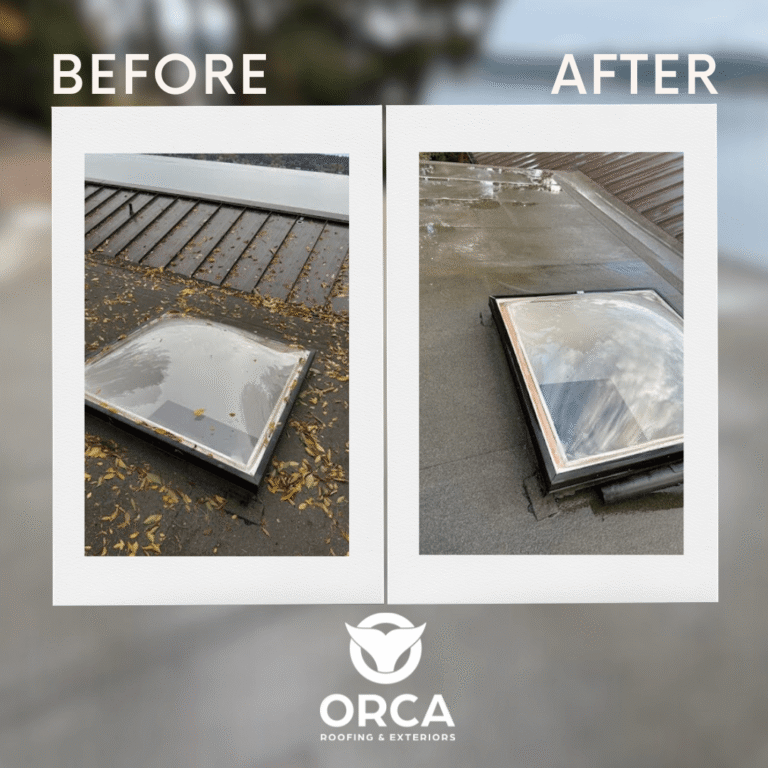
Final Thoughts
A clean roof in Bellevue isn’t just about looks — it’s about protection, efficiency, and long-term home value. Whether you’re maintaining a cedar shake home in Clyde Hill or a modern composition roof near Downtown Bellevue, regular cleaning keeps your roof strong, moss-free, and ready for any season.
Ready for your next roof cleaning? Contact Orca Roofing & Exteriors for a professional inspection and detailed quote — your trusted local team for Bellevue roof care done right.
If you need a roofing service contact our roofing contractors in Bellevue
FAQs – Roof Cleaning in Bellevue
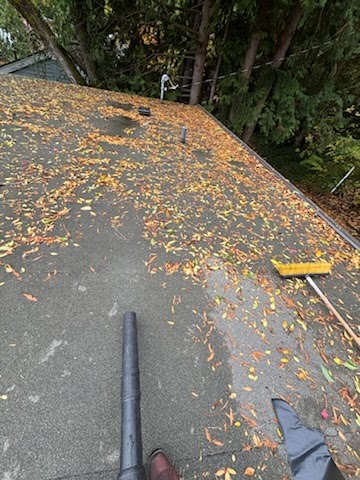
How much does roof cleaning cost in Bellevue?
Most professional roof cleanings in Bellevue range between $600 and $1,200, depending on your roof’s size, material, and moss buildup. For a detailed quote, you can request an estimate from Orca Roofing & Exteriors.
How often should I clean my roof in Bellevue’s climate?
Most roofs benefit from cleaning every 2–3 years. However, cedar shake roofs or shaded homes surrounded by evergreens may need cleaning every 1–2 years to prevent moss and algae growth.
Can I pressure wash my own roof?
It’s not recommended. High-pressure washing can damage shingles and void manufacturer warranties. Professionals use soft wash systems that clean safely and effectively without harming your roof.
What’s the best time of year for roof cleaning in Bellevue?
Late spring through early fall is ideal — the weather is dry enough for moss treatment to work properly, and you’ll have a clean roof ready for the rainy season.
Does roof cleaning really make my roof last longer?
Yes. Regular cleaning removes moss and debris that trap moisture and cause decay. Keeping your roof clean can extend its lifespan by 5–10 years and reduce the need for costly repairs or replacements.
